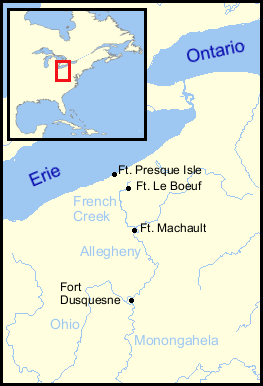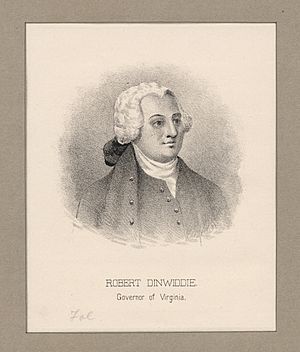Robert Dinwiddie facts for kids
Quick facts for kids
Robert Dinwiddie
|
|
|---|---|
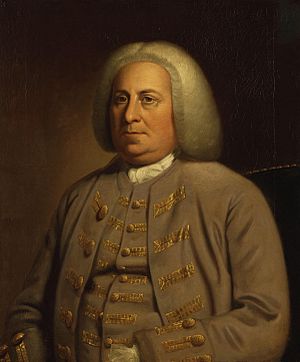
Portrait by an unknown artist, c. 1760-1765
|
|
| Born | 1692 |
| Died | 27 July 1770 (aged 77–78) |
| Signature | |
Robert Dinwiddie (1692 – 27 July 1770) was an important British leader in colonial America. He served as the lieutenant governor of Virginia from 1751 to 1758. At that time, the main governors were often away. This meant Dinwiddie was usually in charge of the colony. He is also known for helping George Washington start his military career.
Contents
Who Was Robert Dinwiddie?
His Early Life and Career
Robert Dinwiddie was born in Glasgow, Scotland, in 1692. His family was well-known. His younger brother, Lawrence Dinwiddie, later became the Lord Provost of Glasgow, a major leader in the city.
Dinwiddie went to the University of Glasgow in 1707. After university, he worked as a merchant. In 1727, he joined the British colonial service. He first worked as a customs collector in Bermuda. Later, he became a surveyor of customs in southern American ports. These roles prepared him for his big job as Lieutenant Governor of Virginia.
Robert Dinwiddie and the French and Indian War
Why Did the War Start?
Many historians believe Dinwiddie's actions helped start the French and Indian War in 1754. He wanted to stop French expansion into the Ohio Country. This area was claimed by Virginia. Dinwiddie was also a part-owner of the Ohio Company. This company had plans for settlements there.
In 1753, Dinwiddie learned that the French had built forts near Lake Erie. These were Fort Presque Isle and Fort Le Boeuf. He saw these forts as a threat to Virginia's land. He worried that places like Winchester, Virginia, were "Exposed to the enemy."
Washington's First Mission
Dinwiddie decided to act. He sent a young George Washington, who was only 21, on a mission. Washington was to warn the French to leave the area. He traveled in the middle of winter, arriving at Fort Le Boeuf in December 1753.
Jacques Legardeur de Saint-Pierre, the French commander, was polite but firm. He refused Dinwiddie's demand. Saint-Pierre gave Washington a letter for Dinwiddie. The letter said he would send Dinwiddie's message to his superior in Quebec. In the meantime, he would keep his post.
Building Forts and Early Battles
Even before hearing the French refusal, Dinwiddie sent Virginia soldiers. Their job was to build a fort where the Allegheny and Monongahela rivers meet. This spot is now Pittsburgh.
The French quickly drove off the Virginians. They built a larger fort there, calling it Fort Duquesne. This fort was named after the governor of New France, the Marquis de Duquesne.
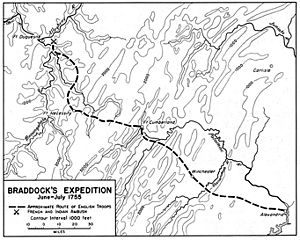
Dinwiddie then appointed Joshua Fry to lead the colonial forces. Fry was ordered to take Fort Duquesne. However, Fry died in May 1754 after falling from his horse. Command of the Virginia soldiers then went to George Washington.
In spring 1754, Dinwiddie sent Washington to build a road. Washington's troops had a skirmish with the French at Battle of Jumonville Glen. Washington then built a small fort called Fort Necessity. Here, he faced the French again in July 1754. Washington was forced to surrender.
Getting British Help
Dinwiddie worked hard to get other colonies to help fight the French. He also convinced the British government to send troops. He wrote to Lord Halifax in October 1754. He explained how the French were invading and how the colonies were slow to help.
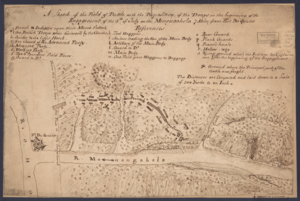
The British sent General Edward Braddock with two regiments of soldiers. Braddock was killed at the Battle of the Monongahela in July 1755. This loss caused much fear in the colony. For the next four years, Dinwiddie often argued with the Virginia Assembly. They disagreed about how to pay for the war. This tension between the government and the colonists later contributed to the American Revolution.
In January 1758, Dinwiddie left Virginia. He was replaced by Francis Fauquier. Dinwiddie lived in England until his death.
Dinwiddie's Lasting Impact
Places Named After Him
Several places are named in honor of Robert Dinwiddie. Dinwiddie County, Virginia, located south of Richmond, is one example. Dinwiddie Hall, a dormitory at The College of William & Mary, was also named after him in 1972.
His Connection to Education
Dinwiddie kept strong ties with his old university, the University of Glasgow. In 1754, they gave him an honorary degree. When he died in 1770, he left £100 to the University of Glasgow Library. This money was for buying new books.
His Family and Records
Robert Dinwiddie died on July 27, 1770. He is buried in Clifton Parish Church in England. He was married to Rebecca Auchinleck. They had two daughters, Rebecca and Elizabeth.
His official records from his time as governor are very important. The Virginia Historical Society put them together in five volumes in 1883. These records cover his years leading the Virginia colony from 1751 to 1758. Some of his papers about the French and Indian War can even be seen online.


